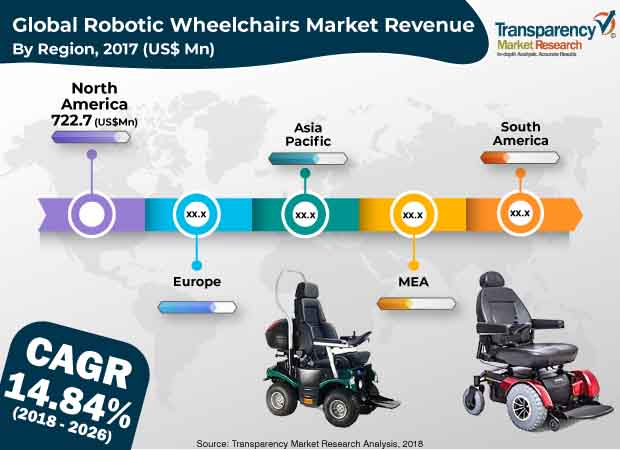
Transparency Market Research has published a new market research report titled ‘Robotic Wheelchairs Market – Global Industry Analysis, Size, Share, Growth, Trends, and Forecast, 2018– 2026.’ According to the report, the global robotic wheelchairs market is anticipated to reach US$ 6,073.9 Mn by 2026. The market is expected to expand at a CAGR of 14.84 % from 2018 to 2026.
Based on drive type, the robotic wheelchairs market has been classified into rear wheel drive, front wheel drive, and mid-wheel drive. The front wheel drive robotic wheelchairs segment is expected to expand at a faster rate compared to the other two segments. Front wheel drive robotic wheelchairs are preferred for their ability of high kerb climbing and other functionalities, which offer short footprints and small turning circles. Mid-wheel drive robotic wheelchairs are preferred mostly in indoor settings. The mid-wheel drive robotic wheelchairs segment is expected to dominate the market as mid-wheel drive robotic wheelchairs are very intuitive to operate. Increase in the number of aging and disabled people is expected to boost demand for robotic wheelchairs. In addition, increase in disposable income of consumers, rise in research & development, and rapid technological innovations in the industry are key factors fueling the growth of the robotic wheelchairs market during the forecast period.

Request a Sample – https://www.transparencymarketresearch.com/sample/sample.php?flag=S&rep_id=55632
In terms of application, the robotic wheelchairs market has been categorized into residential and commercial. The commercial segment is expected to expand at a significant growth rate, owing to a rise in the adoption of robotic wheelchairs at airports, theatres, hospitals, tourist places, etc.. Based on distribution channel, the robotic wheelchairs market has been divided into online channel or offline channel. The online channel segment is expected to remain dominant, owing to significant distribution of robotic wheelchairs through e-commerce sites, company sites, direct sales channels, etc.
An increase in the usage of robotic wheelchairs can led to a sedentary lifestyle. End-user performing minimal physical activity owing to complete dependence on robotic wheelchairs may increase the problem of obesity and various health issues. Physical inactivity may increase the risks of certain cancers, cardiovascular diseases, anxiety, and depression. This factor is likely to hamper the usage of robotic wheelchairs by end-users.
Buy Now:
https://www.transparencymarketresearch.com/checkout.php?rep_id=55632<ype=S
In the current scenario, a rise in demand for robotic wheelchairs in the global market is giving tech savvy customers a new reason to buy this product. Though robotic wheelchairs are sold at high prices, manufacturers are seeing an opportunity in this segment to create a foothold in the near future. In addition to this, technological advancements in robotic wheelchairs that enhance their flexibility and capability are considered a major trend in the market. Various advancements, such as the introduction of smart sensors in wheelchairs, IoT compatibility, and navigational mapping, have made the wheelchair a self-sustained solution for disabled persons. Furthermore, the addition of voice command to manage the mobility of robotic wheelchairs is considered as a major trend across the robotic wheelchair market. This feature in the wheelchair is also expected to improve safety by preventing the collision of wheelchairs. However, there are only a few well-established players with strong distribution networks across different regions. Companies are strengthening their position by continuously investing in research and development (R&D) to come up with solutions to cater to customer requirements.
Ask for brochure:
https://www.transparencymarketresearch.com/sample/sample.php?flag=B&rep_id=55632
Based on geography, the robotic wheelchairs market has been segmented into North America, Europe, Asia Pacific, Middle East & Africa, and South America. North America is a dominant region of the robotic wheelchairs market. The market in the region is expected to expand at a gradual CAGR of 14.11% in terms of value. The market in Europe is expected to expand at a robust CAGR of 16.19%, owing to increase in demand for robotic wheelchairs from the aging population and disabled people in the region. According to the report, the robotic wheelchairs market in Asia Pacific is expected to expand at a CAGR of 15.14%, in terms of revenue, in the coming years. The market in South America is likely to expand at a CAGR of 13.19%. The market in Middle East & Africa is expected to expand at a CAGR of 13.08% in terms of value.
The robotic wheelchairs market is highly competitive with a large number of players present across the globe. Some of the leading industry players profiled in the study include Invacare Corporation, Pride Mobility Products Corporation, Permobil Corporation, Drive Devilbiss Healthcare, Karman Healthcare, and Ottobock SE & Co. KGaA.
TMR’s Latest News Publication –





